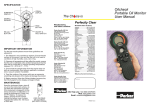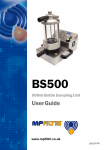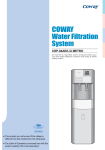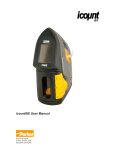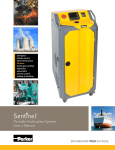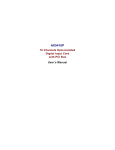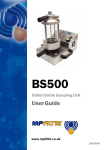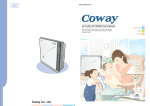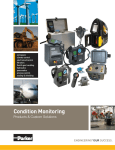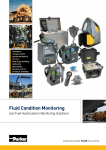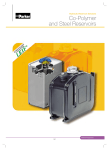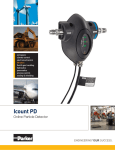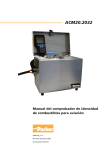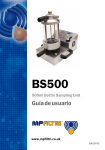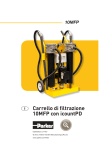Download ENGLISH VERSION UBS OFFLINE
Transcript
UBS OFFLINE USER MANUAL ENGLISH VERSION P.899307 © Parker Hannifin (UK) Ltd, 2006 www.parker.com/cmc Email: [email protected] *****BLANK PAGE***** CONTENTS SECTION PAGE Introduction 3 1. The effect of system conditions 4 2. Fluid sample extraction 5 3. Sample handling and preparation 6-8 4. Operating Instructions 4.1 Primary connections 8 4.2 Inserting bottles 9 4.3 Running the test 9/10 4.4 Testing a new sample or finish testing 11 4.5 peristaltic pump operation 11 5. Pumphead tube fitting (or replacement) 12 1 UBS OFFLINE *****BLANK PAGE***** UBS OFFLINE INTRODUCTION The UBS Offline, already the proven, efficient answer to oil bottle sampling via a monitor has the incorporation of microprocessor technology to recognise and adjust to the CM white light, Laser CM or H2Oil Monitor. The oil sample is drawn into the UBS Offline where it is secured, free from further contamination, in a bottle together with a clean waste bottle by a peristaltic, selfpriming pump. Single operation and efficient testing are assured once the UBS Offline is connected to any of the monitors and powered up using it’s own power source. The oil sample required agitation and de-gassing before carrying out the contamination test. Vacuum chamber and pump options are available. (Standard with UBS.9002). UBS OFFLINE 3 THE EFFECT OF SYSTEM CONDITIONS – 1 1.1 System Flow Rate Samples are best taken from a point in the system where the flow is TURBULENT (Reynolds No. greater than 4000). The turbulent flow creates a mixing action. Where flow is streamline or LAMINAR, larger particulate may tend to settle toward the lower pipe surface and not be sampled. 1.2 System Condition Changes Changes in the system operating condition, flow, temperature, pressure or vibration, can result in previously sedimented contaminant being retrained into the flowing oil. It is also possible that these changes may cause partially contaminated filter elements to shed particulate into the system. Samples should, therefore, be extracted when the system is in a steady state condition and the result less likely to be distorted by contaminant peaks. 1.3 Taking a Sample Extract a sample while the system is operating under consistently controlled conditions. Adopt a consistent technique. i. ii. iii. iv. v. Spill off at least 200 ml of fluid to flush the sampling port of residual contaminant. Leave bottle capped until ready to extract the sample. Fill bottle to approximately 180 ml. Cap bottle immediately after extracting the sample. Complete the label provided and attach to the bottle with band provided. 1.4 Compatibility This unit is capable of automatically distinguishing between the Laser CM, the white light CM20 and the H2Oil. • • The unit can cope with: 2-150cSt when used with a Laser CM 2-250cSt when used with a white light CM20 Test times are 2 mins 15 secs for the Laser CM & H2Oil, and 4 mins 15 secs for the CM20. The unit has a flush cycle of 2 mins. • • 4 UBS OFFLINE FLUID SAMPLE EXTRACTION – 2 2.1 Variations in the sampling flow rate may affect the result from bottle samples. The flow rate through a sampling port from an operating hydraulic system will vary, dependent upon the system pressure, the port restriction and fluid viscosity. For best trend monitoring, it is necessary to maintain these conditions consistently when extracting Bottle Samples. 2.2 There are a number of proprietary sampling valves available which adhere to good theoretical principles. However, they do tend to generate a level of precision and cost which is unnecessary for trend monitoring. 2.3 Sampling points should enable extraction of a sample without changing the system’s condition. Fine control needle valves are not desirable, as they have a tendency to silt up under some operating conditions, causing a distribution of contaminants in the fluid to be changed. The sampling port should be protected to maintain cleanliness and thoroughly flushed before collecting the sample for analysis. 2.4 Allow sufficient airspace in the bottle to enable 80% fill. NOTE: Parker Hannifin part number B.89.907 is a pack of 2 low pressure sample bottles. UBS OFFLINE 5 SAMPLE HANDLING AND PREPARATION – 3 3.1 Bottle Cleanliness It is preferable that bottles have sealing screw caps and both parts are cleaned to a suitable level in accordance with ISO3722. The bottle should not contain more than one tenth the number of particles per 100 ml than are expected to be monitored. Standard Parker Hannifin bottles are supplied clean to ISO13/11 and should not be used to accurately count oils cleaner than ISO16/14 although they may be used for “trend monitoring” at lower levels. The bottle should remain capped until time of sample filling and be re-capped immediately afterwards. 3.2 Sample Mixing Sedimentation of contaminant in a sample will occur, the rate of which is dependent upon both fluid and particle characteristics. Methods of sample agitation have not been provided, as they are likely to inconsistently distort the analysis of results. Samples should be analysed, without delay, once agitated. Where facilities are available, mixing can be achieved using “paint shakers” and/or an ultrasonic bath (for example, 5 mins with a paint shaker, 30 sec in an ultrasonic bath and a further 15 mins with the paint shaker, as indicated in ISO4402:1991{E}. Care should be taken when using ultrasonic baths to avoid distortion of the result by extended use, causing contamination breakdown. Bottle Samples can be sufficiently stirred by swirling and tumbling by hand. 6 UBS OFFLINE SAMPLE HANDLING AND PREPARATION – 3 3.2 De-gassing Usage Instructions WARNING! This chamber must not be used with a vacuum pump/compressor capable of generating a vacuum greater than 100 mbar/abs. 1. Connect chamber to vacuum pump via PVC hose supplied, remove vacuum unit tube A from base leaving top plate in position. Bottle samples must be sufficiently stirred by swirling and tumbling hand prior to use. 2. Loosen sample bottle cap and stand oil sample B in base. Refit vacuum unit tube. 3. Switch on vacuum pump to draw air from oil sample… If oil begins to foam depress ball in vacuum control valve using pin C to slightly reduce vacuum. 4. When oil has de-gassed fully, turn off vacuum pump and depress ball in vacuum control valve to release vacuum in the chamber. 5. Lift off vacuum unit tube taking care to avoid spilling the oil sample. 6. Transfer oil sample over to the UBS Offline for testing. UBS OFFLINE 7 SAMPLE HANDLING AND PREPARATION – 3 3.2 Results The first result from a Bottle Sample should be disregarded, as it could be distorted by fluid from the previous sample. To reduce the effects of mixing variations and sedimentation, it is preferable to average the results of three tests. Individual users may, establish the possibility to reduce this number of tests, dependent upon their requirements and experiences. Samples from different parts of a system will give different results. Consideration should be given to what monitoring is desired and where samples are to be extracted from for suitable trend monitoring to be performed. It is important that whatever practices are adopted by the user, they are performed consistently. OPERATING INSTRUCTIONS – 4 4.1 Primary Connections i. Connect the UBS Offline to a 12V DC power supply using the power lead supplied. Connect to the 12V socket on the rear of the unit. The socket is polarised so that incorrect connection is impossible. Connect the RS232 port to the UBS Offline monitor port on the rear of the unit using the lead supplied. Note – this is not an RS232 link. (Fig. 1) Connect the red (1) monitor coupling to the P1 connector on the rear of the UBS Offline, after first removing the red protective cap on the P1 fitting. (Fig 2) Connect the yellow (2) coupling to the P2 connector on the rear of the UBS Offline after first removing the yellow protective cap on the P2 fitting. ii. iii. 8 Fig. 1 UBS OFFLINE OPERATING INSTRUCTIONS – 4 4.2 Inserting Bottles i. From the front of the unit, screw an empty waste bottle into the right hand connection. (Note that this can only be done when using Parker Hannifin Sample Bottles. When using different bottles; stand in the right side of the unit on the baseplate). If bottle is inserted correctly, it will spin freely. (Fig 3) ii. Mix the sample to be analysed (See Section 3.2) (do not aerate by mixing vigorously). This is important. Do not delay analysis once mixed as sedimentation of contaminant may occur. iii. Remove the lid from the sample bottle taking care not to agitate the bottle thus introducing air into the fluid. Screw the sample bottle into the left hand connection. (Note this can only be done when using Parker Hannifin Sample Bottles. When using different bottles stand in the left side of the unit on the baseplate). If the bottle is inserted correctly it will spin freely. Ensure that DIP tube is at least ¾ into the bottle.(Fig. 4) 4.3 Running the Test i. Ensure power to the UBS Offline is on by depressing the green ON/OFF switch once. The green O/l LED and red STOP LED should illuminate. (Fig. 5) Fig. 3 Fig. 4 Note: In the event that the unit fails to power up, or has been operated outside the recommended limits, it is likely that the integral current overload protection device has been activated. To re-set the unit: 1. 2. Fig. 5 Turn off power supply and leave for approximately 10 seconds. Turn on power supply, the unit is now ready to operate. UBS OFFLINE 9 OPERATING INSTRUCTIONS – 4 i. It is suggested to ensure maximum testing from each sample bottle that for fluid viscosities below 30 cSt the slow speed option should be used. This is activated by depressing the FAST/SLOW switch once. Note: This switch does not illuminate. The unit is now ready for operation. Refer to relevant operator instruction manual to run test. The amber RUN LED on the UBS Offline will illuminate and the UBS Offline pump commence after approx 6-10 seconds. (Fig 6) Once the test is completed the result will be displayed on the monitor. The UBS Offline pump will continue to run for approx. 10 seconds after which the red STOP LED will illuminate on the UBS Offline and pumping cease. (Fig 7) i. To start the next test from the same bottle repeat test procedure. ii. Average the results of all the subsequent tests taken from the bottle to reduce the effects of sedimentation and mixing. Unless the sample size is so small that only one test can be achieved, the first result from the bottle should be disregarded as it could be distorted by fluid from the previous sample. 10 UBS OFFLINE OPERATING INSTRUCTIONS – 4 4.1 Testing a New Sample Or Finish Testing i. To test a new sample, remove sample bottle by unscrewing. Remove waste bottle and dispose of contents in accordance with Hazardous Waste procedures. Note: When testing differing oil types or viscosities cross contamination can occur. For this reason it is advisable to ensure that adequate flushing of both the UBS Offline and the monitor has taken place with the new sample before commencing testing. This can be achieved by depressing the BLACK FLUSH button. This will run the pump for 2 minutes, when set to fast speed, without testing. If required this operation can be repeated once the pump stops by again depressing the FLUSH button. ii. To continue testing return to: 4.2 Inserting Bottles iii. To finish testing: Depress ON/OFF button once and remove 12V DC lead from unit rear. Disconnect monitor hoses and replace red and yellow protective caps. 4.5 Peristaltic Pump Operation The unit has as the pumping force, a Peristaltic Pump. This operates by the occlusion of a tube by a roller system which as the roller engages and disengages with the tube, the tube constricts and recovers to its normal size and draws in fluid. It can be seen from this that this action is self-priming and the pump can run dry. (Although continuous dry use is not recommended). It is advisable that upon completion of testing the unit is flushed through with a cleaning medium. UBS OFFLINE 11 PUMPHEAD TUBE FITTING (OR REPLACEMENT) – 5 The Pumphead Tube will require replacing after approx. 300 hours use. To replace with a new section of tube follow the procedure below. (Fig. 8) i. Undo the two quick release catches on the top of the unit to gain access to the PUMPHEAD. ii. Remove the plastic clip that secures tube around hosetail by disengaging teeth. iii. Remove tube from PUMPHEAD. To replace tube follow diagrams (see below). Note: Ensure that the tube inside the roller housing is evenly positioned halfway up the depth of the housing. iv. Reconnect tube over brass hosetail. v. Position clips around the hose and squeeze jaws together with pliers. vi. Replace the unit top cover. 11 11 UBS OFFLINE 12 The Ch ice is Perfectly Clear Manufacturing and Sales Locations Parker Hannifin (UK) Ltd Hydraulic Filter Division Europe Condition Monitoring Centre Brunel Way Thetford, Norfolk IP24 1HP, UK Phone: +44 (0) 1842 763299 Fax: +44 (0) 1842 756300 Web site: www.parker.com/cmc Parker Filtration BV Hydraulic Filter Division Europe Stieltesweg 8 6827 BV Arnhem The Netherlands Phone: +31 26 3760376 Fax: +31 26 3643620 Parker Hannifin Oy Hydraulic Filter Division Europe Salmentie 260 FIN - 31700 Urjala Finland Phone: +358 20 7532 500 Fax: +358 20 7532 501 Parker Hannifin Corporation Hydraulic Filter Division 16810 Fulton County Rd #2 Metamora, Ohio, USA Phone: +1 (419) 6444311 Fax: +1 (419) 6446205 Worldwide Sales locations Argentina........................... +54 (11) 4752 4129 Australia............................. +61 (2) 9 634 7777 Austria................................... 43-2622-23501-0 Belgium...................................+32 (67) 280900 Brazil..................................... 55-12-3955-1000 Canada....................................1-800-272-7537 Central & South America/Caribbean..................1-305-470-8800 China................................. +86 (21) 6445 9339 Czech Republic...................42-0-2-830-85-221 Denmark................................45-0-43-56-04-00 Finland...................................+43 2622 235013 France................................... 33-0-254-741403 Germany.............................49-0-2131-513-350 Hong Kong...........................+852 (2) 428 8008 Hungary................................. +36 1 220 4155 India........................................ 91-22-790-7081 Italy............................................. 39-02-451921 Japan...................................... 81-3-6408-3900 Jordan.................................... (962) (6) 810679 Korea Choongnam.................. 82-41-583-1410 Korea Kyoungnam.................. 82-55-389-0100 Mexico..................................... 1-800-272-7537 Netherlands........................... 31-0-541-585000 New Zealand..........................+64 (9) 573 1523 Norway.......................................47-64-91-1000 Poland..................................... 48-22-863-4942 Singapore................................. +65 688 76300 South Africa......................... +27 (11) 392 7280 Spain................................... +34 (91) 675 7300 Sweden....................................46-8-5979-5000 Switzerland........................... 41-0-22-307-7111 Taiwan............................... +886 (2) 8787 3780 Thailand.....................................+662 693 3304 United Arab Emirates............... 971-2-6788587 United Kingdom...................44-0-1924-487000 USA......................................... 1-800-272-7537 Venezuela............................ 58-212-238-54-22 NOTE: The (+) sign in front of the country code indicates that you may need to dial an additional prefix. Distributor 24hr Help Line: 00800 27275374 Web: www.parker.com/cmc Email: [email protected] P.899307 Ver.3















